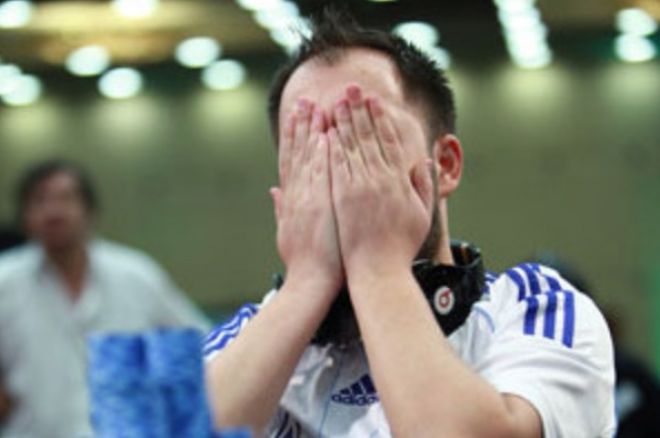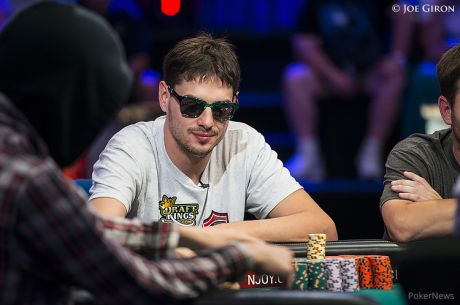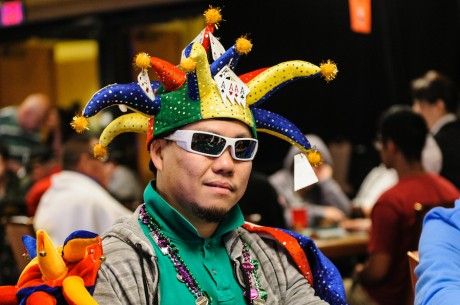Swirling Pressures: Final Table Decisions in The Bigger $162, Part 2

Gareth Chantler continues his discussion of a couple of hands from the final table of The Bigger $162 on PokerStars, today backing up to consider another tricky spot with a pocket pair.
We are eight-handed at the final table of The Bigger $162 in the small blind with 28 blinds and pocket nines, sometimes a very strong hand.
Here are the stacks at the table...
Hero (SB): 28 BB
Big Blind (BB): 60 BB
Under the Gun (UTG): 58 BB
UTG+1: 31 BB
Middle Position (MP): 12 BB
Hijack (HJ): 41 BB
Cutoff (CO): 11 BB
Button (BTN): 20 BB
... and here are the payouts still in play:
1st: $39,723
2nd: $29,051
3rd: $21,936
4th: $16,126
5th: $11,620
6th: $ 9,249
7th: $6,877
8th: $4,506
It folds to the HJ who min-raises and the tight CO player moves all in. The BTN folds, leaving the action on me.
Well, Do You Feel Lucky?
Let��s start with the range of the tight CO. I expect it to look something like 10% of hands �� i.e., 5x5x and better pairs, Ax10x+, KxQx+. But it could be tighter.
I expect the initial raiser in the HJ to be opening somewhere between 35-40% of hands (more likely the latter in my view) as that player had been playing loosely.
If both the BB and I fold, I expect the HJ to call with 12% of hands. But this could be 13%. We are beginning to see how complicated ICM (the ��Independent Chip Model��) can be.
Now let me state this baseline: when I move all in and the BB or HJ calls this shove very tightly, I am losing about $450 dollars every time (which is to say, on average). That is a lot of money to go up in flames �� almost three buy-ins to this tournament.
But 9x9x is a pure coin flip against a range of 5x5x+, Ax10x+, KxQx+. So how is it that we are losing so much money when there is an overlay in the pot? How much does the presence of the BB �� a huge chip leader �� affect our range, for example?
Pretty significantly, actually.
ICMizer (an ICM calculator) doesn��t allow me to run the simulation where BB and/or HJ have no calling range (it doesn��t let you remove AxAx from any calling range, which seems like an oversight). But if we limit their ability to busting me to their chances of waking up with AxAx in either spot, my expected $ return on shoving improves drastically �� from -$450 to +$150, a $600 swing by simply removing AxKx, KxKx, QxQx, JxJx, and 10x10x from their ranges.
So the frequency with which they call with these hands is quite low overall. But when it happens it is devastating to us, and therein lies the rub.
Now what about the first player��s opening range? If we scale that down from 40% to 20%, how is our EV affected? Our shove with two nines just became a -$850 decision. (I say ��we�� and ��our�� as a means to distance and console myself.)
Ready for the twist?
Look again at that 12 BB stack sitting in early position, going unnoticed. If we give that player 40 big blinds and keep all those -$850 factors the same, we��re suddenly only losing $680.
So how important is that guy just hanging out, sight unseen, during the mayhem of this hand? More than you think. This is compounded (but not quantified by ICMizer) by the fact that this particular 12 BB player, who shall remain anonymous, was drawing stone dead to win this tournament by dint of being catatonic.
Finally, what about the stack of the player most likely to bust us if we shove �� that is, the initial raiser in the hijack? If we demote the HJ to 15 BB, we get to break-even.
An Error for All Reasons
So we see that shoving with 9x9x is an error, for a few reasons.
The first is because we risk busting out to the big blind and to the initial raiser. Our hand isn��t strong enough to justify that risk.
A second reason is because the all-in player has a strong range to begin with, being a tight player (who as it turned out would table JxJx in the actual hand).
Thirdly, we have the presence of another short stack primed to go through the blinds. And if that player manages to actualize his or her current stacks�� valuation, it will be through some miracle of cards.
It is principles like these which we can apply to future situations. The case where I am in the big blind myself is different than this case. The case where I am the initial raiser is a snap-call.
Cold, Cold Call
What is also worth exploring, I think, is the possibility of calling. I think this option is better than moving all in.
In the moment there were a few hands in the initial raiser��s range I thought I could make fold with a shove, but might shove over a call. These, namely, were AxJx and AxQx, and perhaps even 10x10x. Those I thought the player might fold to a shove, but if I were to call the player might rip with AxQx or 10x10x, especially. And I would have to fold, miserably.
But how many hands are in the set that will fold to a shove but will continue versus a call? Perhaps just those. And in the larger scheme, that is a real, but small proportion.
In short, calling costs 11 big blinds and shoving costs 28 big blinds. Pound for pound those additional 17 BBs are worth far more than those first 11 BBs.
See where this is going?
It is not worth 17 big blinds to fold out 10x10x and AxQx from the initial raiser��s range, even if we had a guarantee it would. Even if the HJ is opening 20% (which isn��t the case), those hands will make up at most 10% of the opening range, meaning 90% of the time calling is better than shoving. This means calling is better than shoving.
But when we work out the math for just calling, it turns out very close to break-even. Even though we have eliminated some of the risk I took on with shoving, this is still a dicey proposition. That break-even calculation doesn��t factor skill, or lack thereof, in the players around the table. All in all, this was a fold.
It turns out an 11 big blind shove at a final table with eight players left can have quite a good deal of fold equity, even with a raise in front of it, when there are players left to act. The all-in player is in many ways protected from me by the big stacks that surround us both.
We can call this kind of situation counterintuitive. Or we can work through it and situations like it until we start seeing them for what they are.
Gareth Chantler is a professional poker player who encourages you to check out the interviews, videos, promotions, and strategy articles at the Full Tilt Blog.
Get all the latest PokerNews updates on your social media outlets. Follow us on Twitter and find us on both Facebook and Google+!








